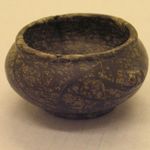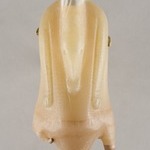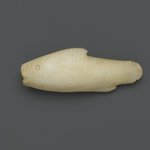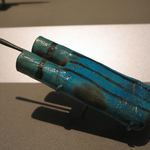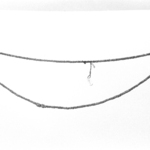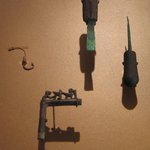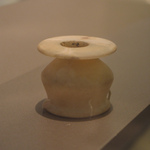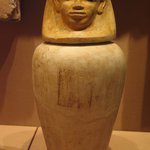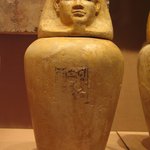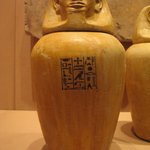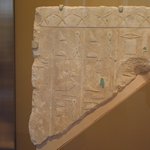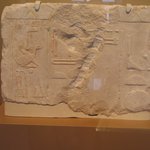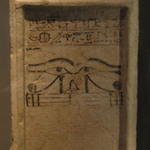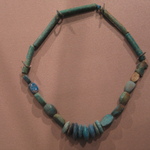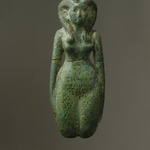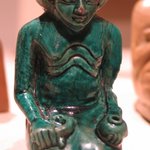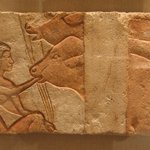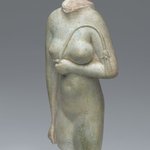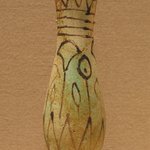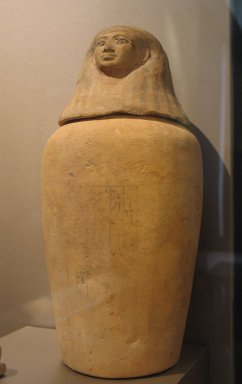
Canopic Jar with Lid in the Form of a Human Head
Egyptian, Classical, Ancient Near Eastern Art
On View: Egyptian Orientation Gallery, 3rd Floor
Canopic Jars
The practice of mummifying human remains led to the development of a new kind of jar.
During the mummification process, the liver, stomach, intestines, and lungs had to be removed to allow the corpse’s interior to dry. In the Fourth Dynasty, the Egyptians began storing these vital organs in four separate vessels, called canopic jars, and burying them with the mummy. Eighteenth Dynasty craftsmen started making canopic jar lids representing the four “Sons of Horus”—deities specifically charged with defending the organs. The human-headed god Imsety protected the liver.
The practice of mummifying human remains led to the development of a new kind of jar.
During the mummification process, the liver, stomach, intestines, and lungs had to be removed to allow the corpse’s interior to dry. In the Fourth Dynasty, the Egyptians began storing these vital organs in four separate vessels, called canopic jars, and burying them with the mummy. Eighteenth Dynasty craftsmen started making canopic jar lids representing the four “Sons of Horus”—deities specifically charged with defending the organs. The human-headed god Imsety protected the liver.
MEDIUM
Limestone, clay, pigment
DATES
ca.1539–1353 B.C.E.
DYNASTY
Dynasty 18
PERIOD
New Kingdom
DIMENSIONS
Other (A): 10 1/4 x 4 5/16 in. (26.1 x 11 cm)
Other (B): 5 7/16 x 3 1/8 in. (13.8 x 8 cm) (show scale)



COLLECTIONS
Egyptian, Classical, Ancient Near Eastern Art
ACCESSION NUMBER
37.1733Ea-b
CREDIT LINE
Charles Edwin Wilbour Fund
EXHIBITIONS
MUSEUM LOCATION
This item is on view in Egyptian Orientation Gallery, 3rd Floor
CAPTION
Canopic Jar with Lid in the Form of a Human Head, ca.1539–1353 B.C.E. Limestone, clay, pigment, Other (A): 10 1/4 x 4 5/16 in. (26.1 x 11 cm). Brooklyn Museum, Charles Edwin Wilbour Fund, 37.1733Ea-b. Creative Commons-BY (Photo: Brooklyn Museum, CUR.37.1733Ea-b_erg456.jpg)
IMAGE
overall, CUR.37.1733Ea-b_erg456.jpg. Brooklyn Museum photograph, 9/6/2007
"CUR" at the beginning of an image file name means that the image was created by a curatorial staff member. These study images may be digital point-and-shoot photographs, when we don\'t yet have high-quality studio photography, or they may be scans of older negatives, slides, or photographic prints, providing historical documentation of the object.
RIGHTS STATEMENT
Creative Commons-BY
You may download and use Brooklyn Museum images of this three-dimensional work in accordance with a Creative Commons license. Fair use, as understood under the United States Copyright Act, may also apply.
Please include caption information from this page and credit the Brooklyn Museum. If you need a high resolution file, please fill out our online application form (charges apply).
For further information about copyright, we recommend resources at the United States Library of Congress, Cornell University, Copyright and Cultural Institutions: Guidelines for U.S. Libraries, Archives, and Museums, and Copyright Watch.
For more information about the Museum's rights project, including how rights types are assigned, please see our blog posts on copyright.
If you have any information regarding this work and rights to it, please contact copyright@brooklynmuseum.org.
RECORD COMPLETENESS
Not every record you will find here is complete. More information is available for some works than for others, and some entries have been updated more recently. Records are frequently reviewed and revised, and we welcome any additional information you might have.



